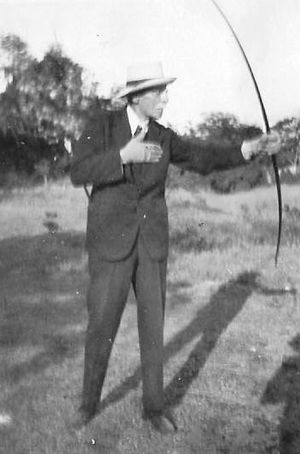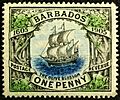Gilbert Thomas Carter facts for kids
Quick facts for kids
Sir
Gilbert Thomas Carter
|
|
|---|---|

Sir Gilbert in his retirement
|
|
| Personal details | |
| Born | 14 January 1848 London, United Kingdom |
| Died | 18 January 1927 (aged 79) Barbados |
| Awards | Knight Commander of the Order of St Michael and St George Companion of the Order of St Michael and St George |
| Military service | |
| Allegiance | |
| Branch/service | |
| Years of service | 1864–1875 |
| Rank | Assistant Paymaster |
| Battles/wars | Third Anglo-Ashanto War |
| Joined Navy (Assistant Clerk) |
14 December 1864 |
| Became a Clerk | 4 July 1866 |
| Placed on Navy List (Became an Assistant Paymaster) |
1 December 1869 |
| Placed on Retired List | 16 August 1875 |
Sir Gilbert Thomas Carter (Greenwich, Kent, 14 January 1848 – Barbados, 18 January 1927) was an important officer in the Royal Navy. He later became a colonial official for the British Empire. This means he helped govern British territories around the world.
He started as a tax collector for the Gold Coast. Later, he managed money for the Gold Coast and The Gambia. He then became the main leader, called an Administrator, for The Gambia. There, he had to deal with problems caused by the local King. After that, he became Governor of Lagos (now part of Nigeria). He worked with local chiefs to create treaties that protected Christian missionaries and helped stop human sacrifice. He also served as Governor for The Bahamas and Barbados. His last job was Governor for Trinidad and Tobago.
Contents
Gilbert Thomas Carter was born in London in 1848. He was the only son of Thomas Gilbert Carter, who was also a Commander in the Royal Navy. Gilbert went to school at the Royal Naval School in Greenwich.
In 1864, Carter joined the Royal Navy. He worked as an Assistant Clerk on different ships. He also worked as a Clerk and an Assistant Paymaster. This meant he was in charge of paying everyone. His last job in the Royal Navy was on a Colonial steamer. While on this ship, he took part in the third war between England and the Ashanti people in the Gold Coast (which is now Ghana).
When the town of Elmina was sold to the British by the Dutch government, Carter helped value the military supplies the Dutch left behind. He left the Navy on 21 July 1875.
Working in West Africa
In 1875, Carter became the private secretary to Sir George Berkeley, who was the Governor of the Leeward Islands. In August 1879, he became the Collector of Customs (someone who collects taxes on goods) and Treasurer (someone who manages money) for the Gold Coast.
From 1882 to December 1888, Carter was in charge of the British colony in The Gambia. He worked as a Treasurer and Postmaster there. From 1886, he was the acting Administrator of the Colony of the Gambia. He officially got the job as full Administrator on 1 December 1888, when Gambia became separate from Sierra Leone.
On 1 January 1890, Carter was given an important award called the Companion of the Order of St Michael and St George (CMG).
In 1891, the local King of Gambia was causing problems for the British colonists. Carter sent a message to the King. He warned that if the problems continued, the British Navy would send warships to punish the King. The King sent the messenger back with a rude reply. In response, Carter sent three British gunboats to show the King the power of the British.
Governor of Lagos (Nigeria)
On 3 February 1891, Carter became the Governor and Commander-in-Chief of the Colony of Lagos (now Nigeria). In 1892, Carter ordered an attack on the Ijebu tribe (part of the Yoruba people). He said this attack was to help bring "civilisation" and end slavery. He believed it was a war to promote a better way of life. In early 1893, Carter traveled through Yorubaland with soldiers. He wanted to show the local chiefs how powerful the British were. Some chiefs did not want him there and told him not to interfere with the slave trade.
In January 1893, the Egba chiefs decided to sign a Treaty of Independence with the British Government. The British Crown agreed not to take over any part of the Egba Nation without their permission. They also agreed that no aggressive actions would be made against the nation, and that its independence would be recognized. The Egba chiefs also promised to stop human sacrifices.
Carter was given another important award on 3 June 1893. He became a Knight Commander of the Order of St Michael and St George (KCMG). This was for his work in Yoruba country and for helping to end a long war there.
Carter also sent works of art made by the Ife peoples of Yoruba to Europe.
Later Life and Retirement
In 1898, Carter was moved to The Bahamas to be the Governor and Commander-in-Chief. He also had a temporary job as the Governor of Trinidad and Tobago. In July 1904, he was moved to Barbados as Governor and Commander-in-Chief.
In 1903, Carter met Gertrude Codman Parker. She was traveling in the Bahamas with her parents. Carter and Parker got married on 25 August 1903 in Boston, USA. Carter had been married before and had three sons and two daughters. His son Humphrey later became the Director of the Cambridge University Botanic Garden.
Carter retired in 1910. In 1919, he changed his surname to Gilbert-Carter. In the early 1920s, he moved back to Barbados. He lived at Ilaro Court, a house designed and built by his wife.
Sir Gilbert Thomas Carter died in Barbados on 18 January 1927.
Images for kids




